In the period that Gillett & Johnston were active, between the late 1800s and the early 1950s, bells were tuned using tuning forks to check their partial frequencies. All three bellfounders in the UK – Whitechapel, Taylors and Gillett & Johnston, had large sets of forks.
Prior to the introduction of electronic tuning aids, the frequency of each partial in a bell was measured by sounding a tuning for close in frequency to the partial and counting beats between fork and partial to determine the exact frequency. The stem of a sounding fork of the correct frequency can also be placed on the bell to stimulate the relevant partial. Sets of forks used for bell tuning cover from very low to very high frequencies in steps of 2 or 4 cycles per second.
A British Pathé video from 1954 shows the latter technique in use at Whitechapel. At 2m15 onwards in the video, after a cut has been made on the bell, Bill Hughes can be seen placing forks on the bell to check a partial. Also visible in the video is a tray of forks with a range of frequencies.
Analysis of the partial frequencies of Gillett & Johnston carillons shows significant discrepancies in frequencies which must be due to errors in the forks. Another page gives examples of carillons and change-ringing bells which show the discrepancies. The forks used in the Croydon foundry are preserved at Taylor’s bellfoundry in Loughborough and this paper describes the forks, how they ended up at Loughborough, and precise measurement of the frequencies of 2,044 of them. Cyril Johnston had a set of 384 portable forks now in the possession of Brian White and I have also measured these.
It has been known since the 1950s that there were errors in the G&J forks but I believe this is the first time that all the forks have been measured, and the nature of their discrepancies made clear. The errors in the fork frequencies follow a surprising pattern: over three or more octaves, the errors cycle across the octave, with the A’s being the flattest and the E♭’s the sharpest. The variation across each octave is 20 to 25 cents, i.e. a fifth or a quarter of a semitone. The very lowest and very highest frequency forks are flat by up to 75 cents or three-quarters of a semitone. Discrepancies in the portable forks show a similar but not identical pattern.
The size of these errors is a significant issue for the tuning of a carillon, and there is every indication that these errors were present when the forks were originally made. The treble bells in G&J carillons have often been replaced or retuned because they are flat. Corrosion from atmospheric pollution has often been blamed for this, but it is also now clear that the forks used to tune them were flat.
History of the forks
Alan Hughes, the last Managing Director of Whitechapel bellfoundry, Richard Offen, onetime employee at Whitechapel, Mike Milsom, onetime Bellmaster at Taylors, and Scott Orr, secretary of the Carillon Society of Britain and Ireland, have all provided information about the forks and I am grateful to them for this. Their contributions are identified with their initials below.
Cyril Johnston purchased the first tuning machine in 1906. (ref 2 page2 21, 27) The first carillon shipped to a customer was produced in 1921. (ref 2 p 273) From the late 1920s or early 1930s the tuning books include more higher frequencies than previous entries.
SO alerted me to the following quote from William Starmer, writing in 1919:
“I had to go to Croydon on Monday re St Luke’s bells. I don’t think there is much to tell you. Johnston has managed to get nearly a major 3rd in the tenor, the quints are not solved. He is but an amateur at the job. He has got forks for every 4 vibs from 78 to 5000. All the lowest forks are on resonance boxes.” (ref 4)
Checking Dove’s guide, St Luke’s is likely to be the chime of 8 at Tunbridge Wells, the only G&J bells delivered to a church dedicated to St Luke that year. Starmer’s name appears on the tenor. SO suggests that because Starmer had made previous visits to Croydon, the forks were purchased with profits from war munitions.
Cyril Johnston died in 1950 having left Gillett & Johnston in 1948. Michael Howard was responsible for the technical side of foundry operations from then on. The business went into receivership in 1957, but from 1955, Taylors had been casting bells for them using G&J profiles. Michael Howard came to Loughborough at least twice to tune these bells, using the Taylor forks (MM). MM, quoting AH, says that G&J continued to use forks for tuning bells up to the very end.
When the Croydon foundry closed, Paul Taylor purchased the forks. Both MM (quoting Paul Taylor) and AH (quoting Douglas Hughes) tell me that this purchase was to prevent Whitechapel buying them, and also because they went up to a higher frequency than the Loughborough sets. However, it soon became clear that the forks were out of tune, and they were never used by Taylors. MM believes that Michael Howard did not know the forks were out of tune.
After the Croydon foundry closed, Wally Spragett, who had worked at Croydon, tuned bells at Whitechapel. RO says that Wally knew the G&J forks were not accurate, due to wear and lack of maintenance. Wally said that because the forks were mostly out by the same amount, the discrepancies didn’t matter. In fact it is clear based on the evidence of 1920s carillons that the forks were wrong from manufacture, even if they subsequently got worse. Because the errors cycle across the octaves, if a bell was tuned true-harmonic with these forks, then the hum, prime and nominal intervals would be octaves despite the errors. RO also suggests that Michael Howard knew the forks were wrong but wasn’t going to own up. AH explains that Whitechapel routinely checked and adjusted their own forks, latterly doing this against their Strobocon electronic tuners. He says it should be no surprise that because Cyril Johnston was a very busy man, he never checked his forks, and in any case didn’t have an accurate standard to work to.
The very highest forks in the G&J set are huge: the 6880Hz fork is almost four inches wide, two inches thick and weighs 1.5kg. When struck, all the high forks sound for a second or less. MM says he tried to use these high forks but they didn’t produce enough vibration to be any use at all. RO, quoting Wally Spragett, confirms that the highest forks were useless, and that all little bell tuning was done using the octave harmonic in lower frequency forks. The lower frequency forks are very powerful and sound for up to a minute even when the tang is resting on a board.
Later in his time at Loughborough, MM sampled about 50 of the forks and created a chart showing their discrepancies, without I believe identifying the octave cycle in the errors.
So it is to the credit of Taylors that despite the G&J forks being of no use to them, they have been kept at the foundry since 1957. The large chest housing the majority of the forks was for many years in the tuning office. Due to a roof leak a few years ago they were moved to the tuning shop where they remain. Some of the forks have suffered water damage but, as will be seen below, this doesn’t significantly affect the conclusions that can be drawn. The 298 highest frequency forks, that were never used either in Croydon or Loughborough, are stored on shelves in the strickle store.
The G&J tuning forks
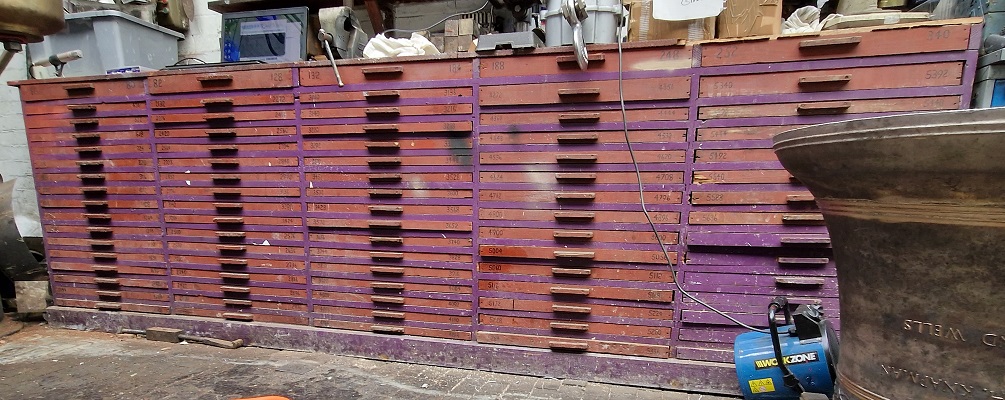
This is the case in the tuning shop housing the majority of the forks. This case came with the forks from Croydon, MM says that Taylors would not have bothered to make a case themselves when the forks proved to be no use. The case contains 81 sliding trays each holding many dozens of forks. Most of the trays are labelled with the lowest and highest frequencies in the tray, up to the tray holding forks 5636Hz to 5680Hz. The last 7 trays (at the bottom of the right hand stack) are not labelled, and these high frequency forks may be among those that were not used.
The top rack of trays has been added to the case as originally constructed, and these house the lowest frequency forks. In the quote above from the letter from Starmer, he says that the lowest frequency forks were mounted on resonance boxes, and many of them have threaded tangs to make this possible. It could be that the top rack of trays was added when the forks were removed from the resonance boxes.
There are at least four different designs of forks, suggesting purchase at different times, and / or from different manufacturers. The forks are in steps of 2Hz from 60 to 128 and 4Hz from that frequency upwards.
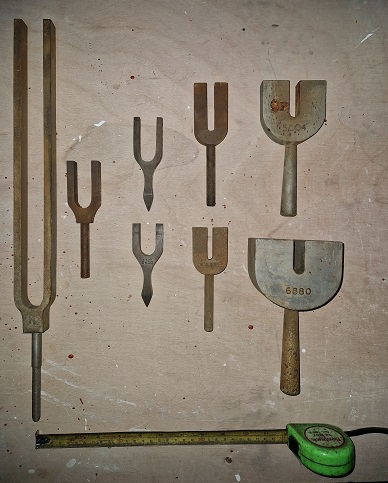 | Series | Lowest | Highest |
| One | 60Hz | 1696Hz | |
| Two | 1700Hz | 3600Hz | |
| Three | 2500Hz | 5000Hz | |
| Four | 5004Hz | 7192Hz |
The forks in the picture are, from the left, the lowest in series one, the highest in series one, the lowest and highest in series two, the lowest and highest in series three, and the lowest and and one of the highest in series four. Some, but not all, of the forks in series one have threaded stems, allowing them to be screwed into a resonator. The rule at the bottom of the picture is opened out to 12 inches to give an indication of the size of the forks.
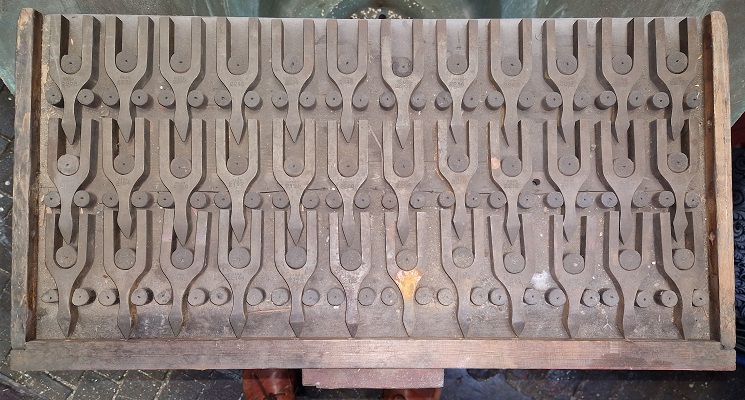
This is a tray of series two forks, covering frequencies 2132Hz to 2272Hz.
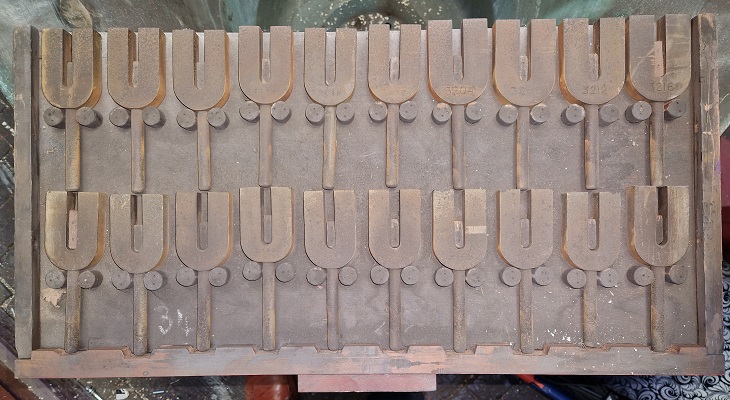
This is a tray of series three forks, covering frequencies 3140Hz to 3216Hz.
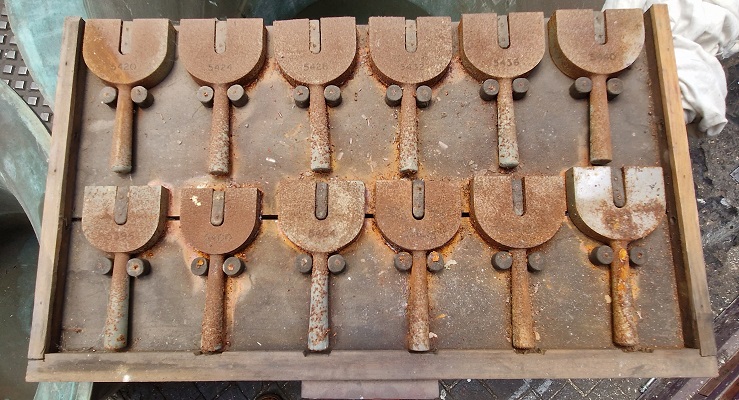
This is a tray of series four forks, covering 5396Hz to 5440Hz. The damage due to the roof leak is clear – this was one of the worst affected trays.
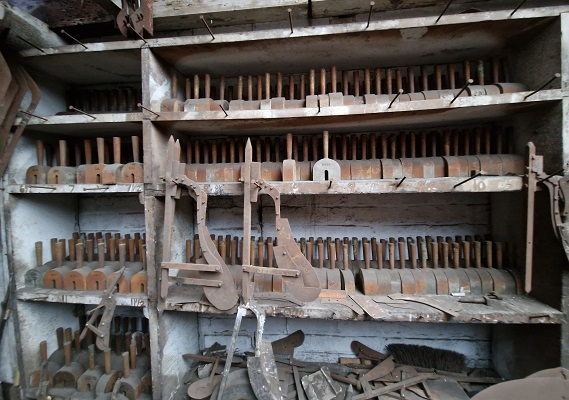
These are the shelves in the strickle store housing the highest frequency series four forks. These forks were never used, either by Gillett & Johnston or Taylors.
Every fork has the frequency stamped on it. Some forks have been restamped with larger punches to make the figures more legible. Each fork from the smallest to the largest has Cyril Johnston’s initials on the opposite side to the frequency.
Based on the letter from Starmer quoted above (giving the highest frequency fork in 1919 as 5,000Hz) and the history of bell production at Croydon, I tentatively propose the following purchase dates for the four series of forks:
- Series one: forks down to 78Hz purchased before 1919, the remainder in the 1920s when bigger bells began to be cast
- Series two: around the late 1910s when large scale bell production and tuning began
- Series three: 1919, before Starmer’s visit in October that year
- Series four: late 1920s or very early 1930s – but these forks were never used.
The frequencies of the forks
On 28 / 29 November and 12 / 13 December 2022 and 17 January 2023 I measured the frequency of 2,044 of the forks. 25 were missing (though some are in the Taylor museum, currently closed for refurbishment) and three could not be measured. One of these is broken, one was too rusty to make a clear sound, and one was lying under the case (having fallen from the tray) and could not be retrieved. In no case were two consecutive forks missing. The recordings were taken with a laptop, microphone and USB preamp. The equipment was calibrated several times against the NIST standard tones during the measurements and was always accurate to ±0.05Hz at 500Hz and 600Hz.
The air temperature in the tuning shop varied between 5 deg C and 10 deg C across the visits. 16 forks across all frequencies were remeasured on more than one visit and the maximum variation in the measurements is 0.8 of a cent – much less than the discrepancies in the forks. So no attempt has been made to compensate for temperature.
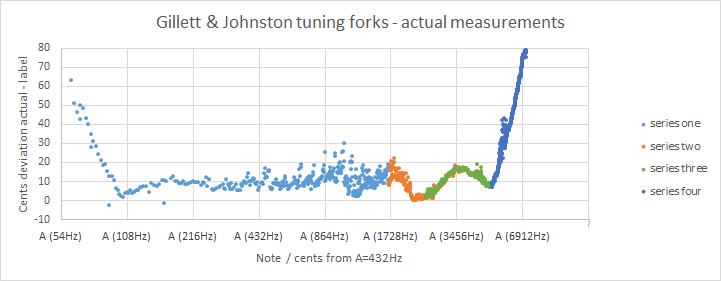
This chart shows the variation in the forks between the frequency stamped on the fork, and the measured frequency. The vertical axis is the difference in cents between the two. The lower the point on the chart, the nearer to the correct frequency. Higher points on the chart indicate that the fork is flatter.
The horizontal axis is the frequency stamped on the fork relative to A=432Hz, given in cents. The choice of frequency standard is arbitrary, the chart would have the same form if plotted with A=440. The vertical divisions are octaves. The data has been presented in this way to emphasise the cyclic variation by octaves.
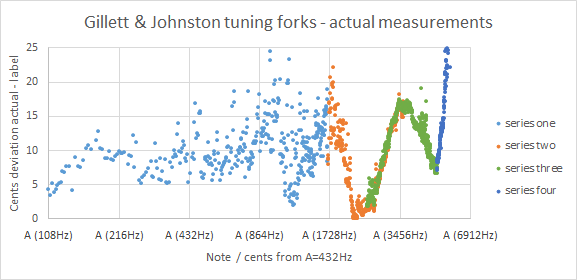
Here is the same data, but plotted with reduced scales on the vertical and horizontal axes. This shows the octave variation much more clearly. It is noticeable that the variation in the series two and three forks where they overlap in frequency is very similar indeed.
Differences between the measured frequency and the stamped frequency can be for at least three reasons:
- errors in original manufacture
- changes due to use of the forks: wear and work-hardening
- rust due to condensation and roof leaks.
It is possible to some extent to separate out these effects. First, all the G&J carillons and peals of bells investigated show the octave variation from A=864Hz upwards, with no major changes in the shape of the curves over a ten-year period. The actual frequency measurements on these forks show the same variation from 1728Hz upwards, and also from 864Hz to 1728Hz but with more scatter. Series two and series three forks follow the same curve where they overlap. So the octave variation from 864Hz upwards must be due to original manufacture.
Second, the forks in the right-hand column of the case (from 5340Hz to 6000Hz) have more water damage than the rest of the forks. A significant flattening of the forks in this frequency range is visible in the first plot. Judging by eye, the additional flattening is between 5 and 10 cents. The extra flattening stops at the point the forks change from those in the case and those in the strickle store, where no rusting due to rook leaks has occurred. So this gives a qualitative sense of the effect of rust on the forks.
In the lower range of frequencies, below 1728Hz, the frequencies of the forks as measured shows more scatter than the deviation of bells in the field. This extra deviation can be due both to wear in the forks through use, and rusting since they came to Loughborough.
Cyril Johnston’s portable forks
As well as the foundry forks, Cyril Johnston had a set of portable forks used in the field, for example for pitching existing bells prior to replacement or augmentation. These forks are much smaller than the foundry forks, and 384 of them fit in a wooden carrying case. I understand from Brian White that when visiting a tower, the forks were carried up the tower stairs by Cyril’s chauffeur.
On 16 November 2022 I recorded all 383 forks in Cyril Johnston’s portable set, held by Brian White, and measured their frequencies to ±0.05Hz . The plot below shows the difference between the frequency stamped on the fork and my measurements, with the same format as above:
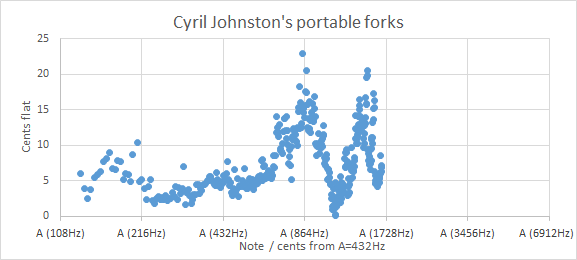
There is clearly a cyclic variation in the top two octaves and the bottom octave of the same scale (20 cents) as the variation I measured in the bells above. The peaks and troughs are at different positions in the octave than for the foundry forks, and the cycle period in the forks is slightly shorter. So these were not tuned to the foundry forks.
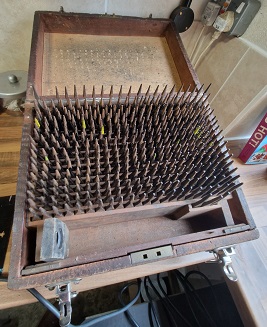
Here is the set of portable forks in their carrying case, at Whites of Appleton. The thin curved sheet of plywood inside the lid serves both to keep the forks in place when the case is carried, and as a sounding board.
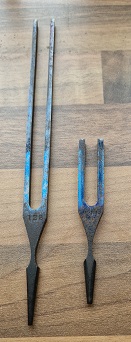
Here are the largest and smallest forks in the set.
Manufacturing errors in these tuning forks
It is clear that the octave variation in both sets of forks must have been present since original manufacture.
Further research, if possible including finding the manufacturer of the forks, is needed. For now, here is a provisional explanation.
When musical instruments such as pianos and organs are tuned without the use of electronic tuning aids, an octave near the middle of the compass is tuned to temperament using counting of beats between overtones of each note. This core octave is then replicated across the instrument by tuning in octaves using the first overtone of each note, which is an octave above the fundamental.
Historically, sets of tuning forks were also calibrated using this method. When the stem of a tuning fork is touched to a sound-board, it sounds an octave first overtone which can be used to tune the octaves. Unlike many musical instruments such as organs and pianos, which can have stretched or shrunk octaves due to physical properties of the instrument, the octave harmonic in a tuning fork is geometrically correct (ref 3). The octave variation observed in these forks can be explained if the base octave used by the tuning fork manufacturer was not correct.
I do not yet have an explanation for the considerable flatness in the very lowest and very highest foundry forks.
Acknowledgements
I am grateful to Andrew Wilby, Chairman of the Loughborough Bellfoundry Trust, for permission to write about the tuning forks at Loughborough, and to Taylor’s staff for help during my visits.
I am also grateful to Brian White for allowing me to measure the set of portable forks, and to the staff of Whites of Appleton for their help during the visit.
I thank Scott Orr for alerting me to the quote from Starmer’s letter.
Finally, I am grateful to Alan Hughes, Mike Milsom, Richard Offen and Andrew Higson for their recollections about the forks, and to Mike Milsom for information about measurements he made of the forks over the years.
References
- Elphick GP, Sussex Bells and Belfries, Phillimore, 1970 page 170
- Johnston J, England’s Child, Cadmus Editions, 2008
- Rossing TD, Russell DA, Brown DE, On the acoustics of tuning forks, American Journal of Physics, 60 (7) July 1992
- Starmer WW, Letter to Denison Taylor 2 Oct 1919, Taylor’s Letter Book T321.